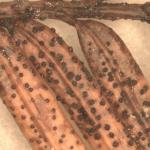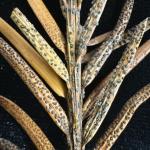Cryptocline Needle Blight
Pathogen
Cryptocline needle blight is caused by the fungal pathogen Cryptocline taxicola.
Hosts
Yews (Taxus spp.) in managed landscapes are hosts of Cryptocline needle blight. Based on samples submitted to the UMass Plant Diagnostic Laboratory, English yew (Taxus baccata), Japanese yew (T. cuspidata) and hybrid yew (T. × media) are all susceptible to infection. The pathogen has also been found on Pacific yew (T. brevifolia) in Quebec (Vujanovic and St-Arnaud 2001) and the native Canada yew (T. canadensis) in Vermont (Morgan-Jones 1973).
Symptoms & Signs
Because yews have so few associated diseases, the damage Cryptocline is able to cause can be quite dramatic at times. Cryptocline often attacks the current season's shoots and needles before they mature and harden off. Foliar symptoms can develop as scattered, pale green to brown-colored lesions that expand over time to consume the entire needle. When the shoots die, the needles are typically held in place and become pale brown. Signs of the pathogen are often absent in the field but after brief periods of incubation in moist chambers, dark and rounded fruiting bodies (acervuli) emerge from both the upper (adaxial) and lower (abaxial) surfaces of infected needles. They may develop tufts of gray-colored mycelia that appears similar to Phyllosticta and Botryosphaeria. Discharged spores are splashed or blown onto nearby shoots and needles to initiate new infections. Little is known about the life cycle, but infections most likely develop in the spring and early summer during mild and wet conditions. It's also possible that the fungus can invade tissues in the fall if environmental conditions are ideal. Shade favors the development of most fungal pathogens, as they require moisture on plant surfaces for spores to germinate and infect.
Management
Overall, Cryptocline needle blight does not appear to be a common disease of yews across our managed landscapes. Plants under stress from wet/heavy soils, transplant shock, drought, among other stresses, are more likely to develop significant disease outbreaks. Prune out and discard all blighted shoots from infected plants. If possible, remove or cover the dead, discarded needles at the base of the plant with mulch since they also harbor the pathogen. If left at the site, the fungus will readily overwinter, allowing C. taxicola to sporulate the following spring and potentially infect next year's new growth, perpetuating the disease cycle. Research and trials are lacking for this pathogen and host but broad-spectrum fungicides such as copper-based products and mancozeb should have some utility against the pathogen. Applications should be made in the spring when new growth is half-elongated and regular intervals thereafter if wet conditions persist. Increasing air-flow and sunlight is also recommended to reduce the time that free moisture lingers on shoots and needles.
Citations
Morgan-Jones, G. 1973. Genera coelomycetarum. VII. Cryptocline Petrak. Canadian Journal of Botany. 51(2): 309–325. https://doi.org/10.1139/b73-039
Vujanovic V., and St-Arnaud, M. 2001. First report of Cryptocline taxicola infecting Pacific yew (Taxus brevifolia) in eastern North America Plant Disease 85(8): 922. https://doi.org/10.1094/PDIS.2001.85.8.922C



